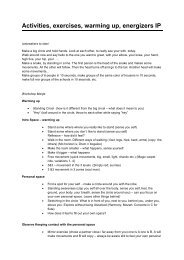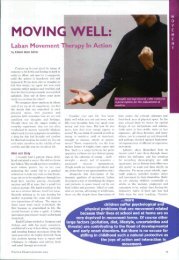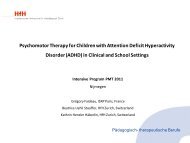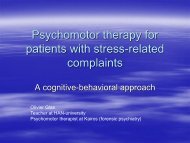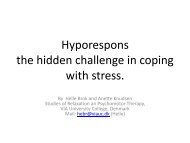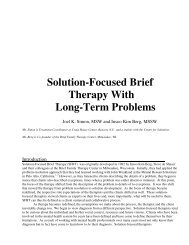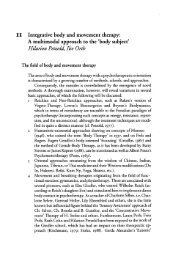Factors and Processes Contributing to Resilience
Factors and Processes Contributing to Resilience
Factors and Processes Contributing to Resilience
You also want an ePaper? Increase the reach of your titles
YUMPU automatically turns print PDFs into web optimized ePapers that Google loves.
I :I<br />
I<br />
214 Karol L. Kumpfer<br />
The primary implication of resiliency research for prevention programming<br />
with high-risk youth isthat prevention programs should focus more directly<br />
on the development of the primary resiJient characteristics identificd in this<br />
review. These resilient traits can be developed by modifying the external<br />
environment <strong>to</strong> increase proteelive processest employing small challenges,<br />
creating opportunities for involvement <strong>and</strong> the demonstration of competence,<br />
<strong>and</strong> increasing involvement, bonding <strong>and</strong> attachment <strong>to</strong> prosocial<br />
groups. Interventions should strive <strong>to</strong> improve the quality of caregiving,<br />
teaching parents <strong>and</strong> youth workers how <strong>to</strong> increase resiliency characteristics<br />
in children, reducing environmental inequities <strong>and</strong> stressors for children<br />
in high-risk or unhealthy environments. Some interventions should work<br />
directly with children <strong>and</strong> youth <strong>to</strong> increase personal power <strong>and</strong> resilience.<br />
Assessments of personal <strong>and</strong> academic competence could provide information<br />
for tailored resilience interventions, possibly through computer<br />
interactive programs or video tapes for caretakers <strong>and</strong> families.<br />
Summary<br />
Why is it that we have invested so much in<strong>to</strong> material <strong>and</strong> scientific<br />
technology <strong>to</strong> build better material goods, yet we know so little about how<br />
<strong>to</strong> build better children? The future success of our country depends on<br />
increasing our technology <strong>and</strong> interest in building better children. For this<br />
reason, increased research in<strong>to</strong> this field of resilience <strong>and</strong> child development<br />
is critical <strong>to</strong> the prevention field <strong>and</strong> our nation's prosperity <strong>and</strong> weil<br />
being. Promoting resilience in youth holds promise for creating more effective<br />
prevention programs. As can be concluded from this extensive review<br />
of research, there are no simple formulas for instiUing resilience. Research<br />
on resilience, while holding much promise for the alcohol <strong>and</strong> drug preverition<br />
field, is also plagued by a number of definitionaJ issues <strong>and</strong> research<br />
limitations. This review suggests that virtually all aspects of a child's personality<br />
<strong>and</strong> environment as weil as transactional relationships between the<br />
child <strong>and</strong> his/her environment inßuence positive life adaptation. Determining<br />
the most salient variables is compJicated by gender, culture, his<strong>to</strong>ry,<br />
local environmental issues <strong>and</strong> developmental appropriateness. A number<br />
of caveats on the quality of the research have been discussed including<br />
issues in theoretical paradigmst definitions, measurement, designs <strong>and</strong><br />
statistical analysis procedures. Because of the increasing willingness <strong>to</strong><br />
see behaviors of individuals as influenced by dynamic transactions with<br />
significant others <strong>and</strong> the environment, studying the predic<strong>to</strong>rs of resilience<br />
have become much more complicated. Additional transactional, crosslagged<br />
prospectfve studies are needed incJuding multivariate data collec-



